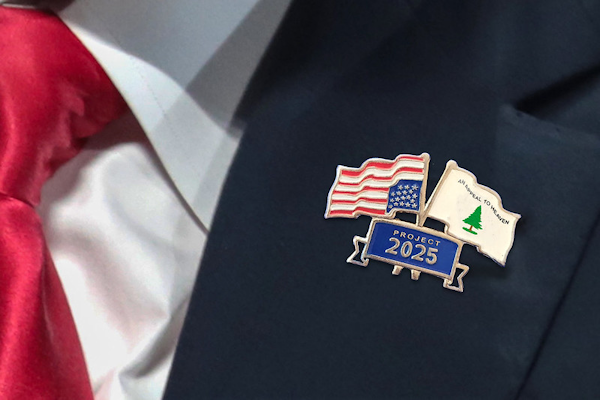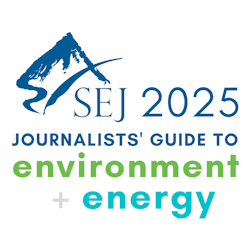SEJournal Online is the digital news magazine of the Society of Environmental Journalists. Learn more about SEJournal Online, including submission, subscription and advertising information.
 |
 |
| The Project 2025 of former President Trump’s allies would downsize the EPA, weaken the influence of career employees and scientists, downplay agency focus on climate change and give more authority to the states for carrying out environmental laws. Photo Illustration: DonkeyHotey via Flickr (CC BY-SA 2.0). |
Issue Backgrounder: What Would Trump 2.0 Mean for the Environment?
By Joseph A. Davis
 |
With the presidential polls so close, the question looms: What would happen on environmental policy in a possible second Trump term? Our guess is that it would be a lot like his first term — but more radical.
We got a hint back this spring when The Washington Post reported on a Trump Mar-a-Lago dinner with oil executives in April: “You all are wealthy enough, he said, that you should raise $1 billion to return me to the White House. At the dinner, he vowed to immediately reverse dozens of President Biden’s environmental rules and policies and stop new ones from being enacted.” Trump told them they would be getting a “deal.”
Congressional Dems are now investigating. Meanwhile, Trump ally Harold Hamm and a billionaire oil investor himself, is working the phones (may require subscription), asking the execs for money.
The incident recalled one back in 2017, when Trump decided not to ban chlorpyrifos, a widely used pesticide that harms farmworkers and children’s neurological health. The U.S. Environmental Protection Agency under President Obama had been set to ban chlorpyrifos when Andrew Liveris, then CEO of Dow Chemical, its manufacturer, wrote a $1 million company check to Trump's inaugural fund.
A few months later, the EPA decided not to ban chlorpyrifos (the agency eventually banned it under President Biden).
Another case, that of Robert Murray, CEO of Murray Energy, as the nation’s largest coal company was then named. Murray gave $300,000 to Trump’s inaugural fund, but did fundraising for Trump as well.
Just weeks after the inauguration, Murray presented the Trump administration with a 3½-page “Action Plan” of things the coal industry wanted, including rollback of power plant pollution regulations and withdrawal from the Paris climate accord. Murray later bragged that Trump had “wiped out most of page one.”
The record of Trump’s time in office during 2017-21 tells a lot of the story.
Project 2025 takes aim at EPA
While the GOP presidential candidate has tried to disassociate himself from the infamous Project 2025 agenda, many still take it as a to-do list for a second term.
The 920-page document was written by many who held office in his first administration. Trump had once praised the effort, although he more recently claimed to know nothing about it.
The Project 2025 chapter on the EPA was principally written by Mandy Gunasekara, the agency’s chief of staff under Trump-era Administrator Andrew Wheeler.
The text does not propose eliminating the EPA, though it does propose downsizing it by a nonspecific amount (notwithstanding that many of the EPA’s functions are mandated by current laws).
What the Project 2025 plan would do
is strengthen the control of political
appointees over the agency.
What the Project 2025 plan would do, however, is strengthen the control of political appointees over the agency and weaken the influence of career employees and scientists. You can get a general idea of its flavor from this nugget: “The EPA has been a breeding ground for expansion of the federal government’s influence and control across the economy.”
And in general, it would downplay agency focus on climate change, which it views as “a favored tool that the Left uses to scare the American public into accepting their ineffective, liberty-crushing regulations, diminished private property rights, and exorbitant costs.”
Another overarching emphasis is to give even more authority to the states for carrying out environmental laws.
Adding overseers, eliminating offices
Anyway, the Project 2025 chapter on the EPA is a long one (31 pages). We offer some bullet points as a quick way to give you a feel. They are far from complete.
- It looks like senior executive service employees would be driven into exile. These are the top career employees in key positions just below the top presidential appointees. The mandate: “Identify relocation opportunities” for SES staff.
- Install a suite of politically vetted overseers on Day 1. These would be identified and vetted ahead of time and would work in “acting” capacity before any congressional confirmation.
- Defang the Office of Science Integrity by eliminating its enforcement authority.
- Eliminate the Office of Environmental Justice and put the remnants in the Office of Administrator.
- Eliminate the Office of Enforcement and put remnants into the program offices.
- Reset the various science advisory boards.
- Return the standard-setting role to Congress (currently, most environmental laws passed by Congress explicitly delegate standard-setting to the EPA).
- Update the 2009 endangerment finding — the legal basis for climate regulations under the Clean Air Act.
- Weaken “new source performance standards” under the Clean Air Act.
- Put policy on auto greenhouse gas emission limits under the Transportation Department.
- Withdraw and replace the EPA’s “waters of the United States” rules protecting wetlands.
- Notify Congress that the EPA will not conduct any ongoing or planned science activity “for which there is not clear and current congressional authorization.”
Trump and climate
Trump has never really acknowledged the reality that human-caused climate heating has begun and that human emissions are causing it. There is no reason to expect a change. During his first term, he worked to promote U.S. production and burning of fossil fuels, which is the largest of many causes of greenhouse gas emissions.
Trump’s campaign has said he would
withdraw again from the 2015 Paris
Agreement if he wins another term.
Trump also announced in June 2017 that he would pull the U.S. out of the 2015 Paris Agreement (although the formal process would take years). President Biden rejoined the treaty. Trump’s campaign has said he would withdraw again if he wins another term.
Trump is famous as well for calling climate change a “hoax.” While he has slightly altered his rhetoric, he has still, during 2024 rallies, enjoyed using the line, “Drill, baby, drill” — to the applause of MAGA crowds.
There’s more. Trump is actively hostile to wind energy. The United States made very little progress on offshore wind during his term in office. Perhaps it all goes back to a legal conflict in which Trump tried to stop a wind farm that he said spoiled the view from the fairway of one of his Scottish golf courses near Aberdeen. He lost that case.
The economic reality is that the transition to green energy will be going forward anyway, inevitably, driven by economic forces, whether fast or slow. Trump claims his “Drill, baby, drill” policy would end U.S. inflation (which is now below 3%). But that makes little sense, since the U.S. now already produces more crude oil than any nation in the world (and exports more liquid natural gas than any country as well).
Then there is the ostrich syndrome. A training video by Project 2025 urges potential Trump officials to “eradicate climate change references from absolutely everywhere.”
The past is prologue
For a summary, take a look at Trump’s deregulation from his first term. The New York Times compiled a good list here. It is almost entirely a story of rolling back and canceling environmental protections set up under previous administrations.
Most, but not all, of the rollbacks were at the EPA. Others were at the Interior Department, the National Oceanic and Atmospheric Administration, the Centers for Disease Control and Prevention, etc.
You may have seen the movie “Groundhog Day,” in which events keep happening over and over. Coral Davenport wrote an insightful piece (may require subscription) for the Times about the pattern of environmental whiplash — in which “rules are imposed, gutted and restored with each election.” She attributes that to the nation’s deep political divisions. A second Trump term would bring more of that, faster.
[Editor's Note: For more on this topic, see WatchDog Opinion columns, "What Would a Second Trump Reign Mean for Press Freedom?" and "Will Journalism Be a Crime in a Second Trump Administration?"]
Joseph A. Davis is a freelance writer/editor in Washington, D.C. who has been writing about the environment since 1976. He writes SEJournal Online's TipSheet, Reporter's Toolbox and Issue Backgrounder, and curates SEJ's weekday news headlines service EJToday and @EJTodayNews. Davis also directs SEJ's Freedom of Information Project and writes the WatchDog opinion column.
* From the weekly news magazine SEJournal Online, Vol. 9, No. 31. Content from each new issue of SEJournal Online is available to the public via the SEJournal Online main page. Subscribe to the e-newsletter here. And see past issues of the SEJournal archived here.













 Advertisement
Advertisement 



